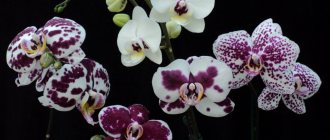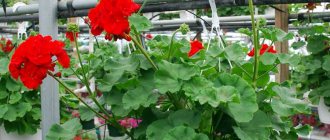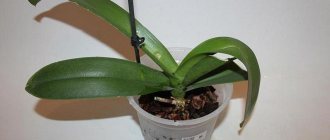Growing an orchid is a responsible and educational activity. The invested work pays off with the aesthetic pleasure that all household members experience when contemplating the lush blossoming of an exotic culture.
How to water orchids in winter and other features of caring for plants in winter will be discussed in the article.
Watering
One of the main requirements is to reduce the frequency and dose of watering. Violation of this rule leads to the fact that the root system simply will not have time to absorb the usual amount of water. As a result, the root shoots rot.
To control the degree of plant moisture, gardeners periodically inspect the roots. A slightly lilac color or light green tone indicates a healthy root system. Dark wet islands indicate the beginning of the rotting process. If the color of the root shoots is gray, the orchid needs watering.
What are the dangers of improper watering of an orchid?
Watering is an integral part of care. If all the rules are followed, the orchid will delight you with its luxurious blooms for many months.
Most flower growers, after purchasing a flower, make many mistakes. One of them is improper watering of the orchid at home. If watered incorrectly, the plant faces:
Root system rotting
- Root rot occurs due to excess moisture. The roots begin to rot and fall off, the flower stops absorbing moisture and dies.
Swelling of leaves due to excess moisture
Damage to the leaf plate after prolonged exposure to water
Lack of moisture leads to drying out of the leaf plate
- If a flower is overwatered or underwatered, problems with the leaves may arise, and the flower will not bloom or will shed unopened buds too quickly.
Stagnation of water at the growing point
- After watering, remove moisture from the growing point with a dry cloth, since stagnation of drops can provoke wet rot.
Placement of the flower
The location of the flower pot plays an important role in winter. If the plants are on the windowsill, you need to protect them from hypothermia. To do this, the pots are placed in a plastic container that has a raised area at the bottom.
This will allow excess water to freely leave the pot, preventing the roots from becoming waterlogged. It is also important to create thermal protection against the flow of cold air coming from the window. To do this, it is enough to install a foam plate between the flower and the glass. The height of the barrier corresponds to the parameters of the pot with a slight increase.
Reference! The absence of stagnant moisture in the soil reduces the risk of developing fungal infections.
Lighting
Another important factor in orchid farming is lighting. Daylight hours are significantly reduced as cold weather approaches. There is a need for additional lighting. It is recommended to purchase a fluorescent lamp with a cold or warm glow.
Its power should be approximately 60 watts. The light source is placed at a distance of 30-40 cm from the flower. The operating mode of the lighting device is selected depending on the length of daylight hours. The plant needs 12 hours of daylight (from 8-00 to 20-00). With a lack of lighting, the leaves begin to wrinkle and their color fades.
Humidity requirements in winter
Orchid loves moist air. But for plants grown in pots, this condition is not so important, because they receive the main moisture from the substrate. Humidity in the air is of secondary importance.
If the orchid is sick or the root system is poorly developed, then the level of humidity in the room plays a major role. This requirement is also relevant for varieties grown on bark blocks or tied orchids.
In winter, the air humidity in the room where the orchids are located should be in the range of 65-80%.
Experienced gardeners purchase air humidifiers to normalize the microclimate with a functioning heating system. A special hydrometer is used to monitor indicators.
How orchids are propagated and replanted at home
Among the main features of properly caring for a houseplant, it is worth noting flower replanting, which can be planned or emergency. In what cases is it recommended to move an orchid to a new habitat as quickly as possible?!
- At the slightest appearance of signs of disease of the root system, the appearance of rot and fungus, as well as various insects.
- The roots do not fit into the container and grow on top of the substrate, which affects the stability of the pot and the condition of the indoor plant itself.
- Decomposition of soil, or its displacement by the root system of a plant.
If the plant looks healthy, the leaves are not damaged by spots, and the roots develop naturally, replanting should be done no earlier than 2-3 years after purchase.
When replanting an orchid, you should follow a certain order:
- before removing the plant from the pot, you must carefully trim the dried peduncle, which recently bore beautiful flowers;
- removing the orchid, carefully inspect the roots and remove the remaining bark and moss using warm running water;
- carefully cut off the unusable dried and diseased parts of the roots, then sprinkle with crushed activated carbon or antiseptic;
- remove yellow and wilted leaves, and leave the plant to dry for 6-8 hours, after which we transfer it to a new container and fill it with fresh substrate for orchids.
Advice! To prevent the growth of bacteria and pests, the planting pot must be treated with a disinfectant and also ensure the presence of a drainage layer. Watering the orchid after planting should be done no earlier than 5-6 days later.
propagated by both experienced gardeners and beginners. To obtain healthy offspring, it is necessary to take into account a number of conditions and follow a step-by-step approach to this difficult but interesting process:
- the optimal air temperature during replanting should be at least 25-27C;
- Only healthy specimens are suitable for successful reproduction - without the slightest signs of damage or disease;
- creating conditions with additional lighting and air humidity of 50-80%.
Reproduction methods
- With the help of children, which are formed both naturally and through stimulation with special substances. With proper care, a plant can delight you with the appearance of basal children, which should be separated from the main stem and thereby obtain a new full-fledged flower. Spontaneous appearance of a baby is also possible on a peduncle with dormant buds, due to the characteristics of the plant and the high humidity of the habitat. To stimulate the appearance of babies from the peduncle, a hormonal agent called cytokinin ointment is used. To do this, you need to apply the drug to a dormant bud in the upper part of the plant branch, after removing the scales with tweezers. Over the course of some time, a sprout will appear in place of the bud, from which a baby will subsequently form.
- Dividing a bush is an effective and trouble-free method of increasing the orchid family at minimal cost. Some varieties of orchids form a fairly powerful and branched root system, which can be propagated by dividing the bush into parts. It is best to plant the plant in the spring, carefully dividing the bush with sharp scissors. After treatment with wood powder, the orchid is planted in a container with a mixture of moss and bark.
- A container with seedlings is the easiest way to propagate an exotic plant. Often such flasks are ordered from orchid greenhouses. There are also special forums where collective orders of seeds from tropical countries are made. After the seedlings reach a certain age, they are removed from the container and rinsed in a weak solution of potassium permanganate. After drying, the plants are placed in a container with a substrate and provided with the required level of humidity, lighting and temperature (at least 25C).
How to properly water an orchid in winter
As winter approaches, the orchid's watering regime changes. This is due to the inhibition of biological processes. Even those varieties that continue to bloom during the cold season need moderate moisture.
Basic rules for irrigation in winter:
- regularity – reduced to 2 times a month (taking into account the humidity in the room and the air temperature);
- methods - mainly using a watering can, root spraying, soaking;
- the amount of water per irrigation is selected depending on the irrigation method and the condition of the roots.
After irrigation, excess liquid should be allowed to drain from the pot. This will help avoid hypothermia and the development of pathogenic microflora on the roots.
Features of flower growth in winter and autumn
In the autumn-winter period, all vital processes in the flower slow down, however, it is at this time that the orchid can release a peduncle and begin flowering. It should be noted that due to the lack of sunlight and lack of proper humidity in the room, the tropical plant may weaken. Therefore, you need to prepare for the wintering period in advance.
After flowering, epiphytes enter a state of dormancy. Often suspended animation occurs during the winter months. Read about watering orchids during flowering here.
Frequency and abundance
During the cold season, the orchid does not go into complete hibernation, so it is not recommended to completely stop watering. Only the frequency of irrigation and the amount of fluid per single procedure are reduced.
Experienced gardeners advise moistening the substrate once every 10 days or even 2 weeks. You should not strictly adhere to these rules; the main guideline is the state of soil moisture.
Reference! Do not let the substrate dry out too much. Overmoistening also has a negative effect on plant development. Therefore, the irrigation process is controlled individually, taking into account the microclimate in the room.
During the rest period
The rest period after flowering is not pronounced in phalaenopsis. But during the cold season, many varieties slow down in development, which is due to natural processes. The frequency of watering is reduced. Particular attention is paid to the irrigation method. When introducing liquid, you should not direct the stream at the plant itself, especially at the center of the outlet. This is fraught with rotting of the flower.
An indicator of the plant's transition to a dormant state is the tips of the roots. A uniform brown color indicates the beginning of rest. Irrigation is carried out no more than once every 14-15 days. As soon as the tips of the root shoots turn green, the plant returns to intensive vegetation. At this stage, the full irrigation regime is restored.
Reference! At stable low temperatures (15-16°) and high humidity, the plant should be watered no more than once a month.
Caring for an orchid after flowering at home
Sooner or later, the long flowering of the orchid, which can last from several months to six months, gives way to a dormant period. Graceful and beautiful flowers fall, and a peduncle remains in their place. In this case, it must be carefully trimmed using garden pruners. The cut site must be treated with a disinfectant to prevent the spread of various infections. Some gardeners recommend treating the cut with beeswax so that when watering, moisture does not get inside and contribute to the formation of mold.
Advice! You should not cut off the green peduncle, since the plant will need a longer recovery period, and the onset of new flowering may even take several months.
Further care for a houseplant does not differ from usual - watering as needed, diffused lighting, regular fertilizing, which contains all the necessary components to restore and strengthen the plant. Also, the period after flowering is the most suitable for replanting, if the flower requires it.
After transplant
It is better to plan a flower transplant at the beginning of spring or immediately after purchasing a flower. Orchid does not like pots that are too spacious. The root system develops poorly in them.
Immediately after transplanting, you need to water the substrate well so that the plant absorbs as much moisture as possible. Then the pot is placed in a container with warm water for 20 minutes. After removing the flower, allow excess liquid to drain. After transplanting, it is better to place the orchid in a shaded place. The first irrigation of the orchid after transplantation is done 2 weeks later. Excess moisture at this stage is detrimental to the crop.
After the end of the adaptation period, proper care is required:
- introduction of fertilizing;
- compliance with the watering regime 1-2 times a week;
- good lighting;
- stable temperature conditions;
- ventilation, but in the absence of drafts.
Is it possible to replant in winter?
Transplanting orchids in winter is not advisable. At this time of year, a period of rest begins. Therefore, it is best to replant after the end of this period. But there are types of orchids that do not have a pronounced sleep period. However, if there is an urgent need for replanting, for example, a disease of the root system or rotting of the upper part of the plant, then replanting can be performed. But unless absolutely necessary, it is better not to disturb the flower and give it time to rest and gain new strength before the active growing season.
After the purchase
After buying a flower, a short quarantine is organized. The essence of the event is to keep the orchid separately from other indoor crops. It is also worth excluding:
- direct exposure of the plant to sunlight;
- introduction of fertilizing;
- watering during the first 5-7 days.
Quarantine is necessary to identify harmful insects or a disease dangerous to other plants. After the end of the inspection period, the flower is placed on the windowsill and irrigated if no pathology was detected.
Reference! Watering orchids after purchase is carried out only after the end of quarantine.
Where to put the orchid pot
An orchid, like any flowering plant, loves bright rooms and moist air. Therefore, without the slightest hesitation, you can place it on the windowsill, or place it in a hanging flowerpot closer to the window. However, some nuances should be taken into account:
- Give preference to windows facing east or southeast. This will provide diffused lighting to the flower and prevent it from direct sunlight during the hot season.
- To prevent the negative impact of dry air during the heating season, it is recommended to increase the width of the window sill, which will reduce the effect of dry heat on the moisture-loving plant.
- When placed on a windowsill, it is better to keep the orchid pot in a small tray of water.
- If the windows in the apartment face south, the window sill is not the best place for an orchid, since its leaves can get burned. It is better to place it near a window, thereby providing diffused lighting.
- When the windows are located to the north, it is necessary to provide the plant with additional lighting using fluorescent lamps.
Alternative methods of watering phalaenopsis
In addition to the usual watering from a watering can, an orchid can be irrigated in other ways.
| Methods for watering phalaenopsis | ||
| Name | The essence of the method | Peculiarities |
| Warm shower | Simple watering with warm water from a watering can or shower. | Suitable for apartments with central heating, where there is high dry air. |
| Dive | The pot is immersed in warm water (a third of the height of the flowerpot). Keep the flower in water for 40 minutes. Then allow the excess water to drain on the tray. | This method is considered the most economical and effective. It can only be used if the plant and substrate are not affected by pathogenic microflora. |
| Root spraying | Irrigation is carried out with a spray bottle, which is directed to the roots of the flower. You need to spray them until the color turns green. | Suitable for orchids growing in blocks. The lack of substrate contributes to the rapid drying of the roots. The procedure should be carried out as the roots dry. |
| Soldering | Place the pot in a bowl without water. The bark is watered until it becomes damp. Let stand for 15 minutes. in water, and then on a tray to remove excess moisture. | This method is an analogue of immersion, but improved. High-quality moisture extends the interval between waterings. |
| "Wet heels" | A pot with a flower is placed inside a flowerpot. Water until 1/5 of the pot is filled with water. | The method is suitable when placing a pot with a flower on a windowsill under which a heating radiator is installed. |
Tips and tricks
Experienced gardeners have their own watering secrets . One of them is soil disinfection during the watering procedure.
Substrate disinfection
To disinfect the soil during watering, add a weak solution of potassium manganese . This will remove fungi and some parasites from the soil. In this case, the immersion irrigation method is used.
IMPORTANT! You cannot often water flowers with potassium permanganate, as this dries out the root system of the flower.
What kind of water do they use?
Water for irrigation should be :
- Soft, water hardness should not exceed 10 degrees (on the German scale), or less than 17 mg/liter on our hardness scale;
- Filtered;
- Warm, at least 30 degrees;
- Defended.
These are important factors that cannot be avoided when watering a plant.
Stimulation of flowering by watering
One type of plant stimulation is reducing watering . To do this, the interval between waterings increases. Experienced gardeners begin to reduce watering in the summer and reduce the frequency by half. After this, you can expect the sleeping flower bud to wake up and begin to grow.
Advice from experienced flower growers
You can learn how to properly water orchids in winter and other phases of the growing season from the advice of experienced gardeners.
- If water gets on the sockets, it is recommended to blot the wet area with a dry cloth.
- The air temperature in the root zone should not fall below 14°. Otherwise, the flower will simply freeze and die.
- Do not overwater the plant. Before watering, you need to inspect the roots. If they are green and condensation is visible on the walls of the pot, there is no need to irrigate the orchid yet.
- Experts do not recommend choosing expanded clay or gravel as drainage. This is due to the risk of contamination of the substrate and plant with many-tailed insects.
- When spraying an orchid, the spray nozzle is removed from the flower at least 20 cm. Small droplets evaporate faster, and large droplets leave unsightly spots on the foliage, which worsens the appearance of the plant.
- The spraying method can be used in winter only if the air in the room is extremely dry.
- When using the submersible irrigation method, you need to replace the water in the basin after each pot. This will prevent the spread of the disease if at least one plant has it.
By following simple recommendations, you can provide orchids with the proper conditions favorable for development and long-term flowering.
An experienced florist on winter watering of orchids:
What can I irrigate with?
In ecologically clean areas, soft rain or melt water can be used for this purpose. Spring water will be ideal for irrigation. The main thing is that the temperature at the time of humidification is about 30°C. Irrigation with cold water can cause disease and root rot.
Tap water can only be used after it has been allowed to sit for 24 hours. It is better to use boiled water, which will not contain pathogenic microflora and chlorine impurities. In order to make hard water softer, you can add oxalic acid or a few drops of lemon juice.
Distilled water is unsuitable for irrigation due to lack of nutrients.
No special fertilizer is required at this time of year, with the exception of orchids under additional artificial lighting. In this case, dry yeast is added to the water for irrigation. Proportion: 1 gram of yeast per 1 liter of water. The resulting solution should be infused for 24 hours.
In small dosages, potassium permanganate, hydrogen peroxide and ammonia are used to prepare solutions. Watering with these substances is used to disinfect plants and as fertilizer.
Learn how to water orchids here.











